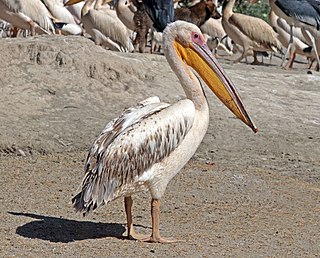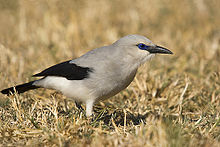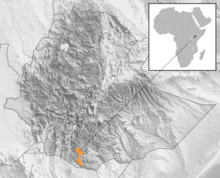
The red-billed chough, Cornish chough or simply chough, is a bird in the crow family, one of only two species in the genus Pyrrhocorax. Its eight subspecies breed on mountains and coastal cliffs from the western coasts of Ireland and Britain east through southern Europe and North Africa to Central Asia, India and China.

The Australian raven is a passerine bird in the genus Corvus native to much of southern and northeastern Australia. Measuring 46–53 centimetres (18–21 in) in length, it has all-black plumage, beak and mouth, as well as strong grey-black legs and feet. The upperparts are glossy, with a purple, blue, or green sheen, and its black feathers have grey bases. The Australian raven is distinguished from the Australian crow species by its throat hackles, which are prominent in adult birds. Older adult individuals have white irises, younger adults have white irises with an inner blue rim, while younger birds have dark brown irises until fifteen months of age, and hazel irises with an inner blue rim around each pupil until age two years and ten months. Nicholas Aylward Vigors and Thomas Horsfield described the Australian raven in 1827, its species name (coronoides) highlighting its similarity with the carrion crow. Two subspecies are recognized, which differ slightly in calls and are quite divergent genetically.

The forest raven, also commonly known as the Tasmanian raven, is a passerine bird in the family Corvidae native to Tasmania and parts of southern Victoria, such as Wilsons Promontory and Portland. Populations are also found in parts of New South Wales, including Dorrigo and Armidale. Measuring 50–53 cm (20–21 in) in length, it has all-black plumage, beak and legs. As with the other two species of raven in Australia, its black feathers have grey bases. Adults have white irises; younger birds have dark brown and then hazel irises with an inner blue rim. New South Wales populations are recognised as a separate subspecies C. tasmanicus boreus, but appear to be nested within the Tasmanian subspecies genetically.

The grey treepie, also known as the Himalayan treepie, is an Asian treepie, a medium-sized and long-tailed member of the crow family. The species was first described by Robert Swinhoe in 1863. They are widely distributed along the foothills of the Himalayas in the Indian Subcontinent and extending into Indochina, southern mainland China and Taiwan. The populations vary in plumage and several are named as subspecies.

The picathartes, rockfowl, or bald crows are a small genus of two passerine bird species forming the family Picathartidae found in the rain-forests of tropical west and central Africa. They have unfeathered heads, and feed on insects and invertebrates picked from damp rocky areas. Both species are totally non-migratory, being dependent on a specialised rocky jungle habitat. Both species are listed as vulnerable to extinction on the IUCN Red List.

The great white pelican also known as the eastern white pelican, rosy pelican or simply white pelican is a bird in the pelican family. It breeds from southeastern Europe through Asia and Africa, in swamps and shallow lakes.

The ring-necked dove, also known as the Cape turtle dove or half-collared dove, is a widespread and often abundant dove species in East and southern Africa. It is a mostly sedentary bird, found in a variety of open habitats. Within range, its penetrating and rhythmic, three-syllabled crooning is a familiar sound at any time of the year. Its name is derived from the semi-collar of black feathers on the lower nape, a feature shared with a number of Streptopelia species. Like all doves, they depend on surface water. They congregate in large flocks at waterholes in dry regions to drink and bathe.

The purplish-backed jay is a bird of the crow family Corvidae, with purple feathers on its back, wings, and tail and black feathers elsewhere. It is endemic to northwestern Mexico, where its habitat is mainly dry deciduous forest. The International Union for Conservation of Nature has assessed it as being a "species of least concern".

Fischer's starling is a bird which is an uncommon resident breeder from southern Ethiopia and Somalia to eastern Kenya and Tanzania. It is found in dry open acacia thornbush.

The wattled starling is a nomadic resident bird in eastern and southern Africa. It is a species of grassland, open woodland, and cultivation.

The Taita fiscal or Teita fiscal is a member of the shrike family found in east Africa from southeastern South Sudan, southern Ethiopia, and western Somalia to northeastern Tanzania. Its habitat is dry open thornbush and acacia and other dry open woodland.

The yellow-faced myna is a species of starling in the family Sturnidae. It is found in New Guinea and nearby smaller islands, where its natural habitat is subtropical or tropical moist lowland forests. The long-tailed myna was formerly included as a subspecies. One of the largest species of starling, this species attains 23 to 26 cm in length and weighs around 217 g (7.7 oz). They have dark plumage with a metallic lustre and bright orange facial markings and beak. These birds are social and omnivorous. Their diet consists of fruit and insects for which they forage high in the canopy. They are common birds with a wide range, and the International Union for Conservation of Nature has assessed their conservation status as being of "least concern". It was named after Charles Dumont.

The black-collared starling is a species of starling in the family Sturnidae. Its plumage is black and white, with a black collar. It is found in southern China and most of mainland Southeast Asia, and has been introduced to Taiwan, Malaysia and Singapore. Its habitats include grassland, dry forest and human settlements. The International Union for Conservation of Nature (IUCN) has assessed it as being of least concern.

The bushy-crested jay is a species of bird in the family Corvidae. It is found in Central America, where its natural habitats are subtropical or tropical moist montane forests and heavily degraded former forest. There are two subspecies, C. m. melanocyaneus which is found in Guatemala and southern El Salvador, and C. m. chavezi from Honduras and northeastern Nicaragua.

The white-tailed swallow is a small swallow belonging to the family Hirundinidae and is endemic to Oromia, Ethiopia. It is commonly referred to as "Benson's swallow" after the ornithologist Constatine Walter Benson, who named the species. This small bird is classified as a vulnerable species by the International Union for Conservation of Nature (IUCN), as there is a progressive declination of the species which now consists of less than 10,000 adult individuals worldwide. It has a surprisingly small range for a swallow, as it is wholly dependent on a cooler "bubble" surrounding its small range, likely for proper breeding success. It is one of the most threatened bird species by climate change and a massive range reduction is projected in the future.

Hall's babbler is a small species of bird in the family Pomatostomidae most commonly found in dry Acacia scrubland of interior regions of eastern Australia. Superficially similar to the white-browed babbler this species was only recognised during the 1960s, which makes it a comparatively recent discovery. The bird is named after the Australian-born philanthropist Major Harold Wesley Hall, who funded a series of expeditions to collect specimens for the British Museum, during which the first specimens of Hall's babbler were collected in southwestern Queensland in 1963.

Burhinus is a genus of birds in the family Burhinidae. This family also contains the genus Esacus. The genus name Burhinus comes from the Greek bous, ox, and rhis, nose.

The Bornean treepie is a passerine bird belonging to the treepies genus, Dendrocitta, of in the crow family, Corvidae. It is endemic to the island of Borneo. It is sometimes treated as a subspecies of the Sumatran treepie.

Yabelo Wildlife Sanctuary is a protected area and wildlife sanctuary in southern Ethiopia. It is located in the Borena Zone of the Oromia Region west of the town of Yabelo, having an area of 2,500 square kilometers and elevations ranging from 1430 to 2000 meters above sea level. The wildlife sanctuary borders on Borana National Park to the south.

The rook is a member of the family Corvidae in the passerine order of birds. It is found in the Palearctic, its range extending from Scandinavia and western Europe to eastern Siberia. It is a large, gregarious, black-feathered bird, distinguished from similar species by the whitish featherless area on the face. Rooks nest collectively in the tops of tall trees, often close to farms or villages, the groups of nests being known as rookeries.






















